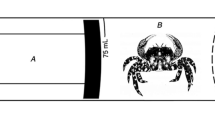Abstract
Three species of bryozoans—Membranipora membranacea (L.), Electra pilosa (L.) and Conopeum reticulum (L.) — are capable of acclimating to elevated temperatures, above the normal range experienced in nature, when exposed to a gradual increase in ambient temperature. Conspicuous differences in LD 50 values, as a consequence of acclimation, occur between representatives of the same species acclimated and grown at constant temperatures in the laboratory. The tolerance range of these species is influenced by their thermal history in the laboratory. While increased ambient temperatures accelerate growth rate, final colony size attained after prolonged exposure declines at higher temperatures. The size of zooecia attained is inversely proportional to the test temperature. Colonies of E. pilosa maintained at 22°C develop erect branches. Hence, it is probable that E. pilosa forma erecta is only a growth form of normally encrusting colonies of E. pilosa. Temperature affects rate of regeneration.
Similar content being viewed by others
Literature cited
Brett, J. R.: Temperature. Animals: fishes. (Functional responses). In: Marine ecology. Vol. I. Environmental factors, Part 1. pp 515–560. Ed. by O. Kinne. London: Wiley Interscience 1970.
Bullivant, J. S.: The rate of feeding of the bryozoan Zoobotryon verticillatum. N. Z. Jl Freshwat. Res. 2, 111–134 (1968).
Friedl, H.: Koloniebildung, Besiedlung und Wachstum bei marinen Bryozoen. Arb. zool. Inst. Univ. Innsbruck 2, 139–168 (1925).
Fulton, C.: Environmental factors influencing growth of Cordylophora. J. exp. Zool. 151, 61–78 (1962).
Garside, E. T.: Temperature. Animals: Fishes. (Structural responses). In: Marine ecology. Vol. I. Environmental factors, Part 1. pp 561–573. Ed. by O. Kinne. London: Wiley Interscience 1970.
Gautier, Y. U.: Recherches écologiques sur les bryozoaires cheilostomes en Méditerranée occidentale. Recl Trav. Stn mar. Endoume 38, 1–434 (1962).
Grave, B. H.: The natural history of Bugula flabellata at Woods Hole, Massachusetts, including the behaviour and attachment of the larva. J. Morph. 49, 355–383 (1930).
Jebram, D.: A cultivation method for salt water Bryozoa and an example for experimental biology. 1st I.B.A. International Conference on Bryozoa. S. Donato Milanex. 1968. Atti Soc. ital. Sci. nat 108, 119–128 (1968).
—: Preliminary experiments with Bryozoa in a simple apparatus for producing continuous water currents. Helgoländer wiss. Meeresunters. 20, 278–292 (1970).
Kinne, O.: Über den Einfluß des Salzgehaltes und der Temperatur auf Wachstum, Form und Vermehrung bei dem Hydroidpolypen Cordylophora caspia (Pallas), Athecata, Clavidae. Zool. Jb (Abt. allg. Zool. Physiol. Tiere) 66, 565–638 (1956).
—: Über die Reaktion erbgleichen Coelenteratengewebes auf verschiedene Salzgehalts- und Temperaturbedingungen. Zool. Jb. (Abt. allg. Zool. Physiol. Tiere) 67, 407–486 (1958).
—: The effects of temperature and salinity on marine and brackish water animals. I. Temperature. Oceanogr. mar. Biol. A. Rev. 1, 301–340 (1963).
— (Ed.) Marine ecology. Vol. I Environmental factors, Part 1. 681 pp. London: Wiley Interscience 1970a.
—: Temperature. Animals: invertebrates. In: Marine ecology. Vol. I. Environmental factors, Part 1. pp 407–514. Ed. by O. Kinne. London: Wiley Interscience 1970b.
— and Paffenhöfer, G.-A.: Hydranth structure and digestion rate as a function of temperature and salinity in Clava multicornis (Cnideria, Hydrozoa). Helgoländer wiss. Meeresunters. 12, 329–341 (1965).
—: Growth and reproduction as a function of temperature and salinity in Clava multicornis (Cnidaria, Hydrozoa). Helgoländer wiss. Meeresunters. 13, 62–72 (1966).
Marcus, E.: Beobachtungen und Versuche an lebenden Meeresbryozoen. Zool. Jb. (Abt. Syst. Ökol. Geogr. Tiere) 52, 1–102 (1926).
Mawatari, S.: The natural history of a common fouling bryozoan Bugula neritina (Linnaeus). Misc. Rep. Res. Inst. nat. Resour., Tokyo 19/21, 47–54 (1951).
Menon, N. R. and N. B. Nair: The ectoproctous bryozoans of the Indian waters. J. mar. biol. Ass. India 9, 430–433 (1967).
Kinne, O.: The growth rates of four species of inter-tidal bryozoans in Cochin backwaters. Bull. natn. Inst. Sci. India. (In press).
Nair, N. B.: Ecology of marine fouling and wood boring organisms of western Norway. Sarsia 8, 1–88 (1962).
Paffenhöfer, G.-A.: Nahrungsaufnahme, Stoffumsatz und Energiehaushalt des marinen Hydroidpolypen Clava multicornis. Helgoländer wiss. Meeresunters. 18, 1–44 (1968).
Ryland, J. S.: Bryozoans, 175 pp. London: Hutchinson 1970.
Schneider, D.: Der Aufbau der Bugula-Tierstocke und seine Beeinflussung durch Außenfaktoren. Biol. Zbl. 78 (2), 250–283 (1959).
Stebbing, A. R. D.: Growth of Flustra foliacea (Bryozoa). Mar. Biol. 9, 267–273 (1971).
Author information
Authors and Affiliations
Additional information
Communicated by N. K. Panikkar, Panaji
Rights and permissions
About this article
Cite this article
Menon, N.R. Heat tolerance, growth and regeneration in three North Sea bryozoans exposed to different constant temperatures. Marine Biology 15, 1–11 (1972). https://doi.org/10.1007/BF00347433
Accepted:
Issue Date:
DOI: https://doi.org/10.1007/BF00347433




